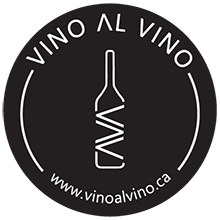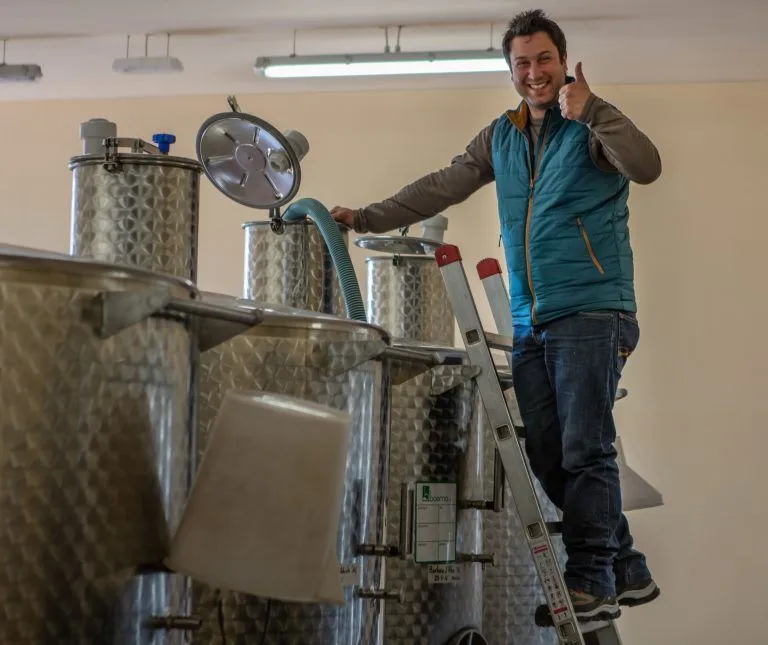Champagne | The In-Depth Guide
The image of a bubbly wine, in a flute, inevitably evokes an association with one particular wine: Champagne. The wine that we usually uncork on special occasions to celebrate the good in life. The wine that is cherished by both wine aficionados and wine newbies for its fine bubbles, beautiful perlage, seemingly endless nuances, and exquisite taste.
Can you tell? We love champagne! But do we really know everything there is to know about Champagne? This fascinating wine can only be called Champagne if it is made using a special process that requires a lot of dedication and patience: the Champenoise method. Thanks to it, Champagne obtains not only its characteristic bubbles, but also its complexity in aroma and flavor.
In this article, we will not only tell you about the Champenoise method. You will also learn about the
different classifications of Champagne, and
what are the major differences
between this sparkling wine,
Cava and
Prosecco, two wines that share similarities with Champagne.
What is Champagne?
Champagne is a sparkling wine made in France. Of course, not all sparkling wine can be called Champagne. A sparkling wine must have a number of characteristics to have the Champagne appellation:
- First, it must be made in the Champagne region, located in northern France (part of the administrative region of Eastern France).
- At least 51% of the grapes must come from that region.
- Grapes are exclusively hand harvested.
- Finally, Champagne must be made with a specific method, known as Method Champenoise (we will talk about it later).
The Champagne Region
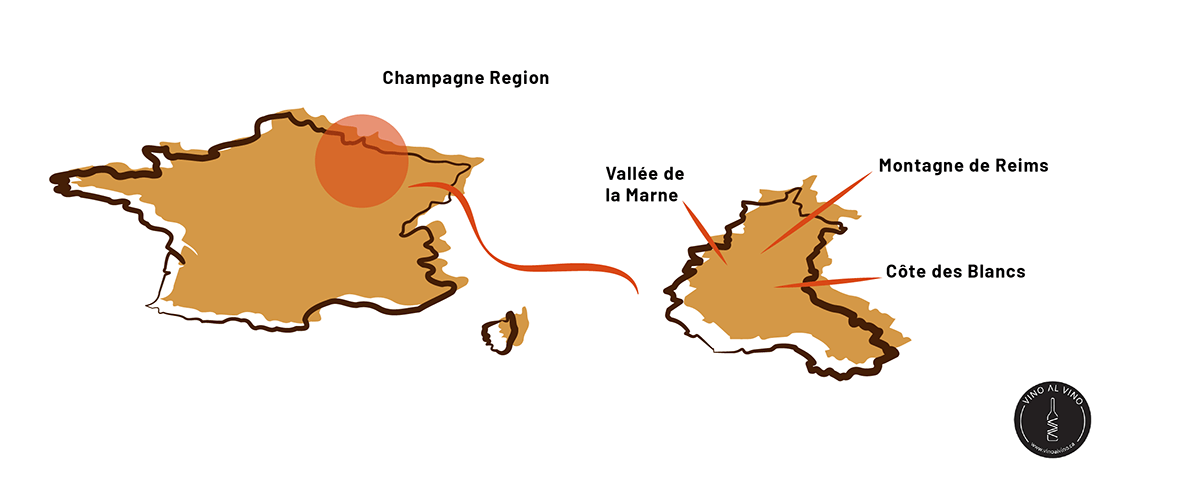
The Champagne region covers an area of about 35000 ha, spread across 319 villages. The climate, soil, subsoil and topography create a very distinct terroir which gives the wine unique characteristics.
The subsoil is limestone, predominantly chalk. Chalky soil is stony and free-draining. Deposited organic matter can decompose rapidly, making them difficult to keep fertile. Exactly the harsh environment needed to produce wines of distinction and high acidity making them easy to pair with many foods.
The Champagne region is influenced by both Oceanic and Continental climates offering regular rainfalls throughout the year. The chalky soil, coupled with abundance of sunshine, provide the ideal condition to drain the excess water in summer. But those same conditions present a bug threat for growers in winter and spring. Especially in the last few years, Champagne growers have lost as much as 50% of their yields to late frost in Spring. This is putting an upward pressure on prices.
The most important areas for the cultivation of grapes for Champagne are:
This region is located between the Marne and Vesle Rivers, extending 30 km from east to west and 6 to 10 km from north to south. The most predominant plantings in this region are of the Pinot Noir variety, although Chardonnay can be found in Trépail and Villers-Marmery. The Champagne wines produced in this region have a very particular appeal, as they are robust, have a crispy palate and are very fragrant.
Vallée de la Marne (Marne Valley)
The Vallée de la Marne (the Marne Valley) region extends from Tours-sur-Marne and Epernay to the city of Paris, mainly along the right bank of the Marne River.
This region has two grand cru regions: Aÿ and Tours-sur-Marne. But undoubtedly where the best quality Champagne is produced is in the grand cru Aÿ. In this area, the most delicate sparkling wines are produced, with an exceptional body and a very delicate nose.
This region is located a few kilometers from Epernay, and borders the Brie de Champagne plateau, covering 10 to 15 km. White grape varieties are usually grown here, the most cultivated variety being Chardonnay, with 95% of the production.
The champagnes produced in this region have the term "blanc de blancs" (white of white grapes). Côte des Blancs has
6 Grand Cru regions:
- Avize
- Chouilly
- Cramant
- Le Mesnil-sur-Oger
- Oger
- Oiry
- Côte de Sézanne: Côte de Sézanne is a region located southeast of Étoge. Although it is technically an extension of the Côte des Blancs, it is considered an independent sub-region. Côte de Sézanne has 1417 hectares of vineyards, of which 75.1% are devoted to Chardonnay, 18.6% to Pinot de Noir and 6.2% to Pinot Meunier.
- Aube: This region, located 40 km northeast of Chablis, accounts for 1/5 of Champagne production. Aube is made up of Cotes des Bar, Bar sur Aube, Bar sur Seine, the Montgueux mound and a small portion of vineyards located south of Sezanne.
The main grapes grown in this region are:
- Pinot Noir
- Chardonnay
What is the Cru classification? How does the cru classification work?
The Cru classification is a scale used to establish the quality levels of the different Crú (on a village rather that site level) in France. It takes into account factors such as:
- Grape quality
- Soil type
- Climatic conditions
In an effort to not repeat the Champagne riots of 1910-1911, a classification system was designed that assigns a rating to the vineyards, in the Champagne region. This classification is composed of the following levels: Autre Crú, Premier Crú and Grand Cru. A percentage based system, known as the Échelle des Crus ("ladder of growth"), acts as a pro-rate system for determining grape prices. According to this classification, the price per kilo of grapes will be more or less negotiable at the time of the transaction between the winegrowers and the Maison de Champagne (buyers).
- Autre Crú vineyards can achieve between 80 and 90% of the set price for the grapes.
- Premier Cru vineyards can achieve between between 90 and 99%.
- Grand Cru vineyards can achieve between 100% of the set prices.
What is Champagne made of?
Although there are 7 different types of authorized grapes, the most commonly used ones are:
- Chardonnay
- Pinot Noir
- Pinot Meunier
These three varieties account for about 99% of the region’s plantings.
What are the other white grapes of Champagne?
- Pinot Blanc
- Pinot Gris
- Petit Meslier
- Arbane
The above grape varieties play an important but more of a support role. Winemakers use them judiciously to accentuate a desired taste or flavour profile.
What are the different types of Champagne wines?
Champagne can be of 3 types depending on the grape varieties used in its making:
- Blanc de Blancs (translates to "white of whites"): a Champagne of this style is made from 100% white grapes, hence the name "white of whites". Most commonly it is all Chardonnay grapes, although other grapes used can be Pinot Blanc, Petite Meslier, or Arbane.
- Blanc de Noirs (translates to "white of blacks"): this style is made entirely from red grapes. A fun fact, in most languages around the world, red grapes are referred to as black grapes. The grapes used are Pinot Noir or Pinot Meunier, or a blend of the two.
- Rosé: The Rosé champagnes or pink champagne is achieved by blending white wine with a little bit of red wine such as Pinot Noir or Pinot Meunier (usually 10% or less). The red wine used for blending has low tannin levels, a high acidity and a fruity flavor profile, with notes of strawberry or raspberry. Usually, rosé champagnes have a more intense fruity flavor that Blanc de Blancs.
Also, during the second fermentation of Champagne, sugar and yeast are added, in a procedure known as Dosage. Depending on the amount of sugar added in the Dosage, it is possible to obtain different sweetness levels:
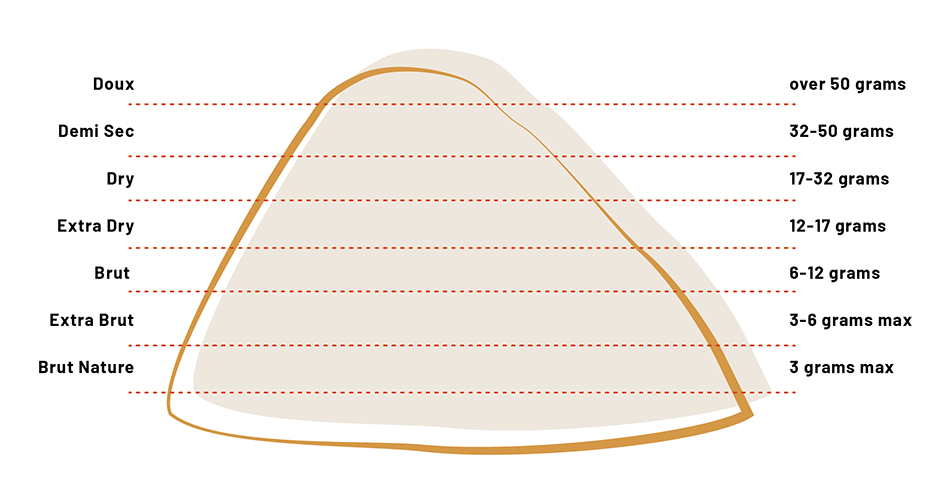
- Brut Nature: They have practically no residual sugar, and even some Champagnes of this type have no sugar at all. They can contain up to 3 grams of residual sugar per liter.
- Extra Brut: Although they still are very dry sparkling wines, they have higher sweetness levels than Brut Nature. It can contain between 3 and 6 grams of residual sugar per liter.
- Brut: It is the most popular style of Champagne. It can contain between 6 and 12 grams of residual sugar per liter.
- Extra Dry: Also known as Extra Sec is in the intermediate range of sweetness. It can contain between 12 and 17 grams of residual sugar per liter.
- Dry: Also known as Sec or Seco, despite this label it is a significantly sweeter wine than Brut. They can contain between 17 and 32 grams of residual sugar per liter.
- Demi-Sec: A Demi-Sec Champagne can contain between 32 and 50 grams of residual sugar per liter, and is one of the sweetest Champagnes.
- Doux: Finally, Doux is the sweetest Champagne of all. It has more than 50 grams of residual sugar per liter.
What is Grower Champagne?
As the name suggest, Grower Champagne is crafted by grape growers and their families. These are the independent vignerons and vigneronnes that are crafting artisanal, highly coveted Champagne wines. They grow grapes in their own vineyards and produce cuvées that reflect their distinct vineyards and style.
Our favourite grower champagne comes from a small winegrower, Champagne Lelarge-Pugeot. Champagne Lelarge-Pugeot dates back to 1799, an eighth-generation winery in the Premier Cru village of Vrigny on the rolling slopes of the Montagne de Reims. They’re a true family operation, led by parents Dominique Lelarge and Dominique Pugeot and their children, Clémence and Valentin.
Lelarge-Pugeot has been certified organic since 2014 and Demeter-certified biodynamic since 2017, farming 42 distinct parcels of Pinot Meunier, Pinot Noir, and Chardonnay at elevations of roughly 400 ft. Lelarge-Pugeot’s wines are styled in a minimalist fashion that brings a bright freshness teeming with energy while also delivering developed tertiary toasty and nougat nuances. This family is producing bubbles as juicy and immediately rewarding as they are age worthy. Truly distinct Champagne all around, earning The Independent’s Best Overall for their top Champagnes of 2021.
What is not Grower Champagne?
The other two types of champagne producers are:
- Champagne Houses (Maisons de Champagne): They make up 8o+% of Champagnes wines. Champagne houses buy their grapes, using the Échelle des Crus system, from lots of grape growers from all over the region and outside of the Champagne region. The Houses focus on blending grapes from different regions and vintages to produce a consistent taste every year. The most popular brands in this category are Moët, Veuve Clicquot, Krug, Perrier, Bollinger, etc. many of which are owned by LVMH (Louis Vuitton Moët Hennessy). Business Wars: Season 71 Gucci vs. Louis Vuitton provides a fascinating account of the rise of LVMH. Definitely worth a listen!
- Cooperatives (Co-ops):
Co-ops are typically wines from a specific village in Champagne and from the grapes grown around that specific village. the primary reason why growers opt-out to join the co-op is because they don’t have all the sparkling wine making equipment. Typically, the growers supply the grapes to the Co-op and the chief winemaker for the Co-op makes the cuvées. Champagnes can be labeled individually for a specific grower or they can be labeled as a co-op brand. Co-op Champagnes are typically labeled with the letters ‘CM’ for ‘Coopérative Manipulant’.
How is Champagne made?

Making champagne is as much as art as it science and blending is at its epicenter. Champagne, as mentioned above, is made using the Champenoise method (aka traditional method or the Champagne method), a method very similar to the one used in Cava. This consists of a series of steps, which we will explain below:
1. First fermentation
In the first step of the Champenoise method (or the Champagne method),
still wine is produced. This wine does not yet have the characteristic bubbles of Champagne, but it will be
the basis for a good final result.
Generally, white grapes such as Chardonnay are used to obtain a Blanc de Blancs Champagne, and black grapes such as Pinot Noir or Pinot Meunier to make a
Blanc de Noirs style Champagne. After selecting the grapes, they are pressed
to obtain grape juice. This is how the still wine is obtained.
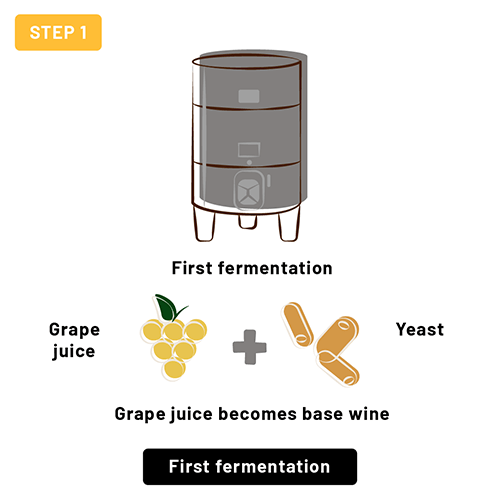
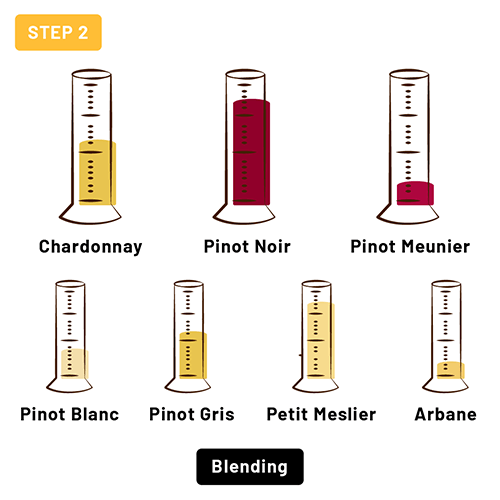
2. Blending
In this step, the particular blending of the wines of each Champagne house is carried out. For this, still wines from different vintages are usually blended to achieve a wine with a unique profile. A small amount of still red wines can also be added to white wines to obtain a Rosé champagne.
3. Second fermentation
In the second fermentation the magic happens: here the characteristic bubbles appear. For this, the wine is first bottled, and then a small amount of sugar and yeast is added. After this, is placed a crown cap in the bottle and the bottle is left to settle horizontally. The second fermentation starts when the yeast begins to convert the sugar into alcohol and carbon dioxide. Since it cannot leave the bottle, the carbon dioxide remains inside the bottle, in the form of bubbles.

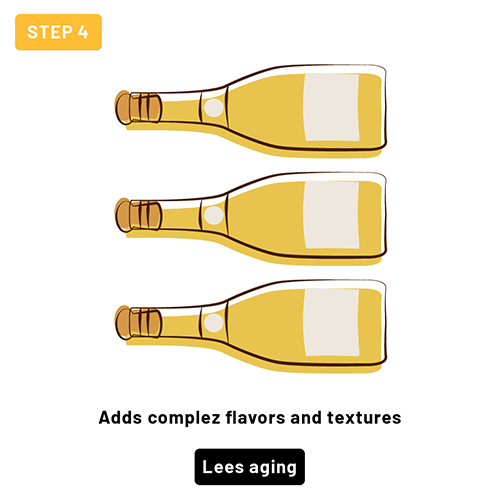
4. Lees aging
At this stage, the Champagne remains in contact with the lees (a by-product of secondary fermentation) for a period of time. The time will vary depending on the type of Champagne to be made: i) In the case of non-vintage champagne, producers must leave the wine in contact with the lees for at least 15 months; ii) In the case of vintage champagne, the wine must be in contact with the lees for at least 3 years. This process is key to giving Champagne bread dough notes in aroma and flavor, as well as adding complexity to the wine
5. Riddling
After the wine has been in contact with the lees for some time, they are expelled from the bottle. But before that, the Riddling process must be performed: First, the champagne bottles are placed at a 45º angle. Then, they are manually rotated every few days. At the same time, they are shaken a little to move the yeast cells and sediments towards the neck of the bottle. Gradually, the angle of the bottles is modified, until they are vertical.

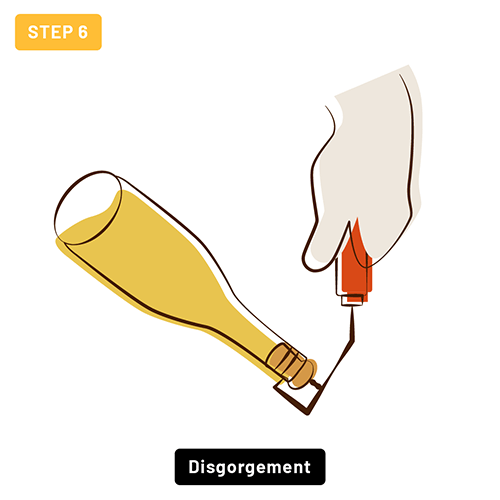
6. Disgorgement
Through this process, the yeast cells and sediments are removed from the Champagne. In the particular case of Champagne, this process is usually done manually, unlike what happens in Cava. First, the neck of the bottle is immersed in a freezing solution. This causes the yeast cells to freeze. Then, the crown cap is removed from the bottle, and thanks to internal pressure the yeast cells are expelled from the bottle, along with a small portion of wine.
7. Dosage
Here, a small part of wine is added to replace what was lost in the previous step, with a particular amount of sugar. This amount will depend on the type of wine you want to achieve (Extra Brut, Brut, Sec, Demi Sec...).
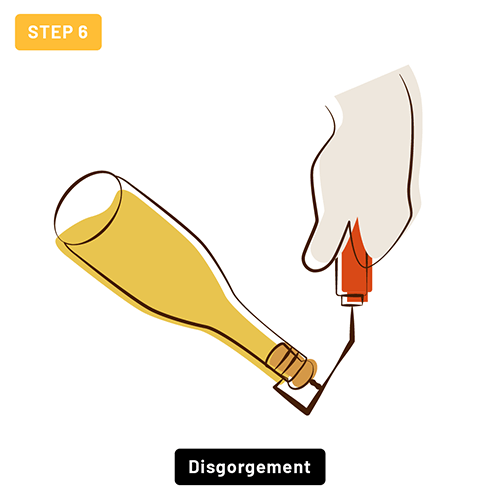
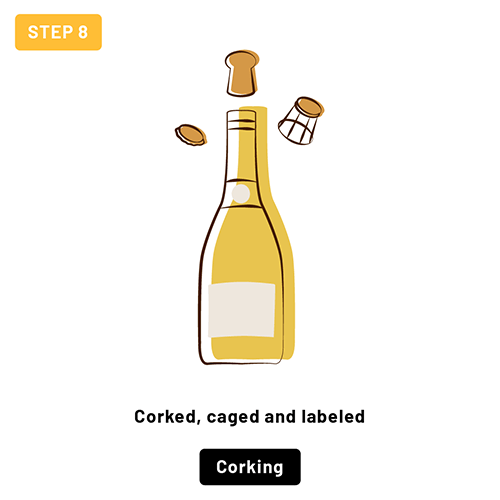
8. Corking
After the dosage is added, it is time to place the champagne corks in the bottles. The corks are then covered by a wire cage, which prevents the champagne corks from coming out of the bottle despite the internal pressure. Once the bottle is corked, it is usually left to settle for a few weeks to several years, depending on the winery and the desired style of Champagne. This process is key to giving Champagne bread dough notes in aroma and flavor, as well as adding complexity to the wine.
What is the difference between vintage and non-vintage Champagne?
Vintage Champagne demotes a wine that is made from the grapes in a single year. It does not denote that the Champagne is old. Non-vintage Champagne, on the other hand, is a blend from different years. In addition, vintage wine must be aged for a minimum of three years in the bottle, as opposed to 15 months for non-vintage wines. Typically, wine producers opt out for vintage wine in exceptional years. Aging, requires both time and space and adds cost to the wine. Then, there is the prestige factor. As such, expect to pay more for vintage wine.
What are the other sparkling wines that use the traditional method?
- Cava is a sparkling wine of Denominación de Origen (DO) status from Spain. It may be white or rosé.
- Franciacorta is a sparkling wine from the Italian Province of Brescia with DOCG status. It is produced from grapes grown within the boundaries of the territory of Franciacorta, on the hills located between the southern shore of Lake Iseo and the city of Brescia
- Vinho Espumante is a type of sparkling wine produced in Portugal. Any region can produce espumante, the name is not protected in the same that Champagne is protected.
What is the difference between the sparkling wines of Prosecco and Champagne?
- Country of Origin: While Prosecco is made mainly in the Veneto region of Italy, Champagne is only made in the Champagne region, located in northwest France.
- Production Process: While Prosecco is produced using the Charmat Method, Champagne is produced by the Méthode Champenoise, a more complex method.
- Fermentation: Although both wines undergo a double fermentation, the place where this occurs is different. In Prosecco, it occurs inside a stainless steel tank, while in the case of Champagne it occurs inside the bottle.
- Grapes: The grapes used for each wine are also different. In the case of Prosecco, at least 85% Glera grapes are used, while grapes such as Verdiso or Chardonnay can also be used. Moreover, the 3 main varieties used to produce Champagne are Chardonnay in Blanc de Blanc Champagne, and Pinot Noir and Pinot Meunier in Blanc de Noir Champagne.
- Atmospheric Pressure: The atmospheric pressure that each wine receives is different. In the case of Prosecco, the pressure can vary between 1 and 4 bars. On the other hand, in Champagne the atmospheres of pressure usually are between 6 and 7.
- Bubbles: In Champagne, the bubbles are smaller and the perlage is much more refined.
- Alcohol Level: Another difference is the percentage of alcohol in each wine. Prosecco typically has a lower ABV than Champagne (11-12% ABV vs. 12-13% ABV).
- Price: Finally, another difference is found on the price. The Méthode Champenoise requires more effort which in turn drives the price higher as the wine receives more input. Champagne has managed to brand itself as a premium sparkling wine which drives a further premium over Prosecco.
The 4 differences between Cava and Champagne
One of the wines that share many similarities with Champagne is Cava. However, they also have some differences that will help you distinguish them:
- The biggest difference lies in the origin of the wines. While Champagne originates from the Champagne region in France, Cava predominantly originates from the Catalonia region, in Spain. The Cava DO is not a contiguous region and there are 3 other areas in Spain that produce Cava under the Cava DO.
- Another difference is the type of grapes used in each wine. Champagne primarily uses Chardonnay, Pinot Noir, Pinot Meunier. On the other hand, while Cava can be made from Pinot Noir and Chardonnay, most Cava will be made from a blend of Macabeu, Parellada and Xarel-lo, which results in a wine that is slightly fruitier and earthier than Champagne.
- The terroir in which each wine is produced is also different. Champagne is produced in the north of France, a region with oceanic and continental climates. For this reason, its climate and soil conditions are different from those of the Mediterranean region of Catalonia, where Cava is produced.
- Finally, another difference is the disgorgement process after the second fermentation. In Cava, typically the mechanical method is generally used, while in Champagne, the manual method is more commonly used.
Final Thoughts
Although Champagne is a more expensive product than apparently similar wines such as Cava or Franciacorta, this is justified by knowing in detail the fantastic process by which this sparkling wine is produced. The particular process of secondary fermentation ends up giving it much finer and more delicate bubbles than other sparkling wines, while the time the Champagne is left in contact with the lees gives it greater complexity. The disgorging process is carried out by hand, and reflects the greater dedication that each vigneron puts into each wine.
Vino Al Vino is a Western Canadian wine wholesaler and wine importer specializing in real wines, wines with minimal intervention. All of our wines are sustainable. Almost all of our wines are certified organic. Many of our wines are certified biodynamic. Many of our wines are full-throttle zero-zero natural wines.
News, Views and Happenings from Vino al Vino
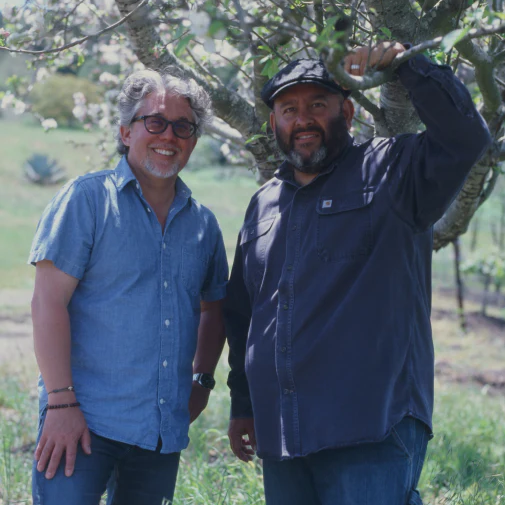
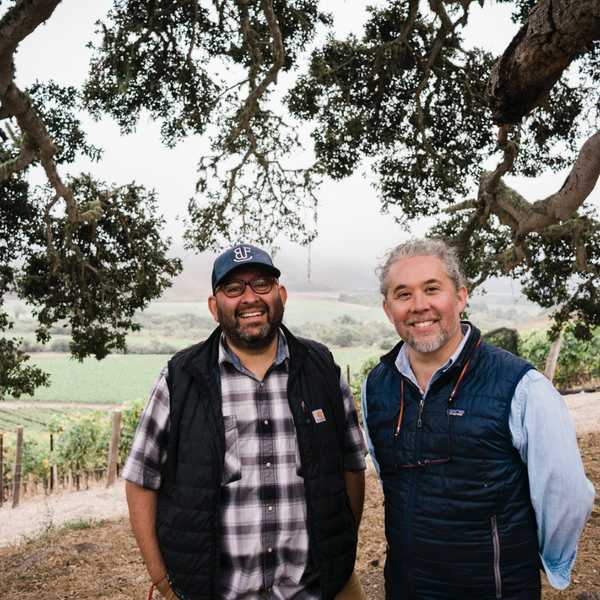
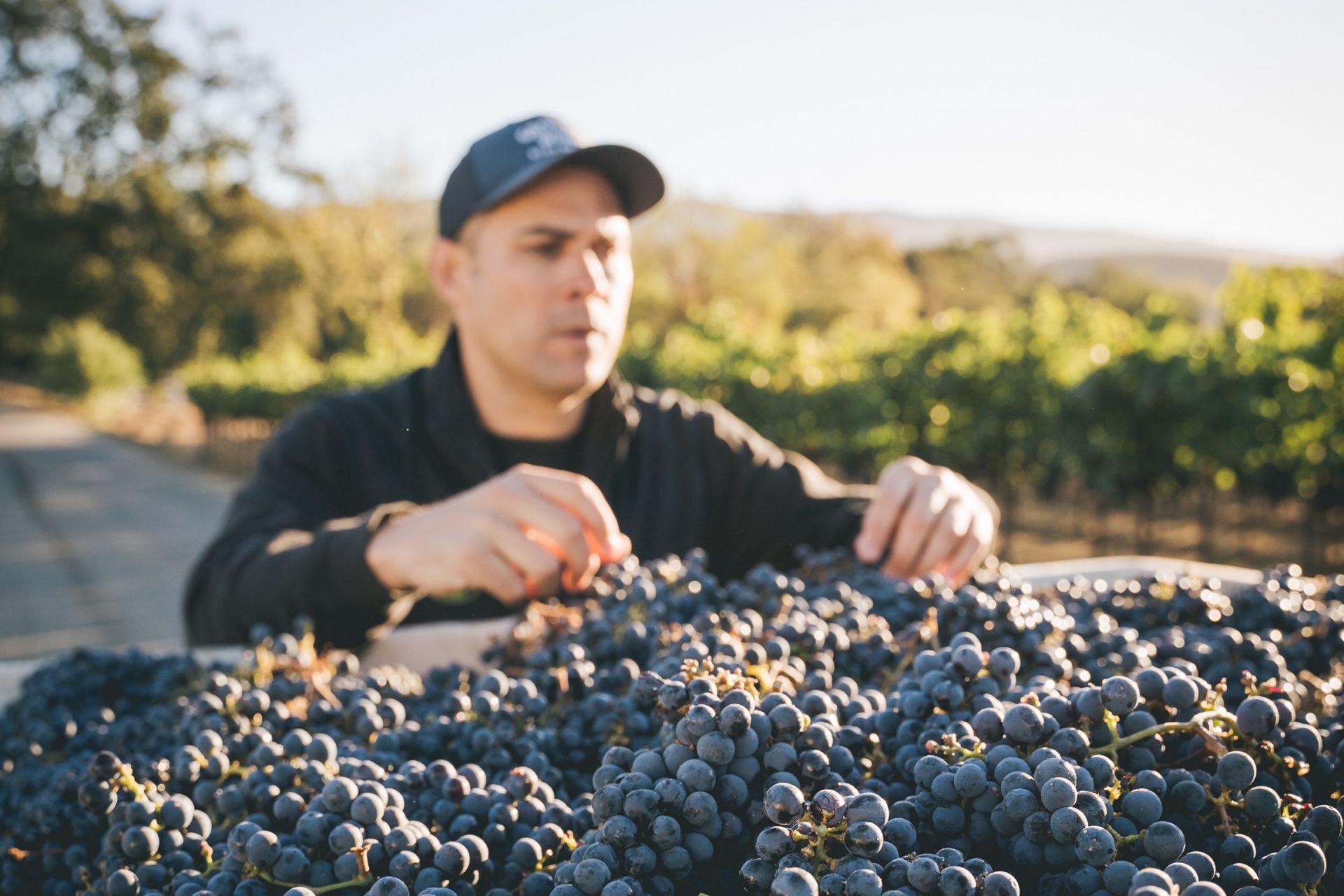
Calgary + Alberta South
Andrew Stewart
403-604-0408
andrew@vinoalvino.ca
Edmonton + Alberta North
Joe Gurba
780-203-5284
joe@vinoalvino.ca
Saskatoon + Saskatchewan
Kerrie Gavin
306-290-0277
kerrie@vinoalvino.ca
Join Our Newsletter*
Contact Us
We will get back to you as soon as possible.
Please try again later.
*By submitting this form, you are consenting to receive marketing emails from: Vino Al Vino Inc. https://www.vinoalvino.ca. You can revoke your consent to receive emails at any time by unsubscribing.
Contact Us
We will get back to you as soon as possible.
Please try again later.
*You are consenting to receive marketing emails from us. You can revoke your consent at any time by unsubscribing.
2014 - 2023 © All Rights Reserved Vino Al Vino Inc.
